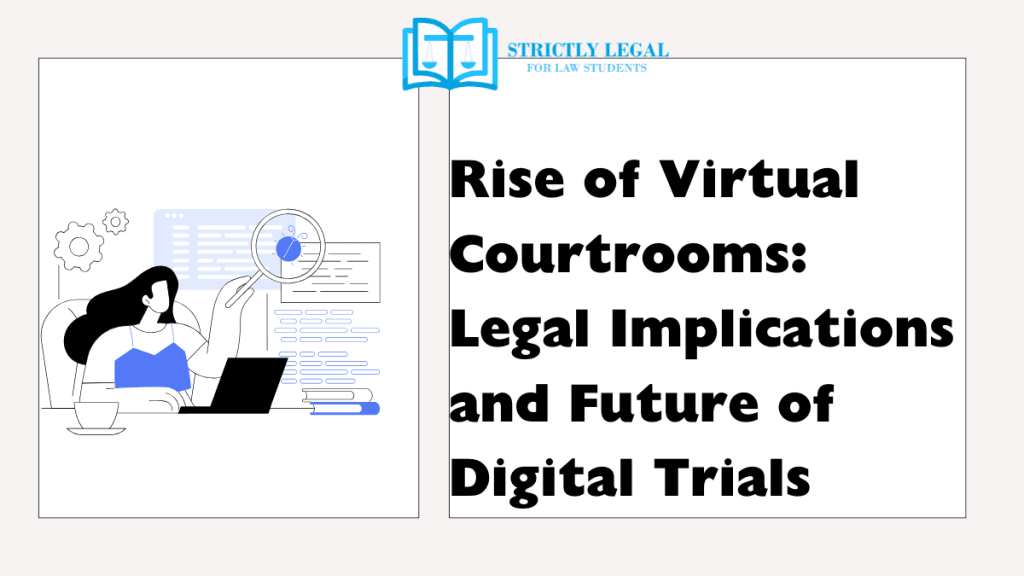The COVID-19 lockdown was extremely difficult for everyone. The judiciary was significantly impacted, as were all other industries and social strata. when it was impossible to approach the courts. One of the cornerstones of government is the judiciary, and the smooth operation of the courts is crucial to the smooth operation of the state. The Hon’ble Supreme Court used its plenary jurisdiction under Article 142 of the Indian Constitution to order courts to use e-courts and virtual courts in order to ensure that justice is delivered to everyone in a timely manner and with adequate functioning. The entire legal system benefited from this guidance, which has since taken on a completely new shape. Access to justice has been facilitated by the adoption of new technologies by our judiciary, which guarantees that everyone can obtain justice without needless delay or expense. The Honorable Chief Justice of India, DY Chandrachud, recently ordered all high courts to let attorneys to participate in virtual hearings during court procedures. In order to allow many lawyers and interns learn a lot and acquire experience without physically visiting courts, access must not be restricted to their cases alone.
Table of Contents
What exactly is a virtual court?
Under the e-courts project, the Indian legal system introduced the idea of virtual courts for the trial and adjudication of minor offenses. To save time and money, virtual courts do away with the need for plaintiffs and advocates to appear in person. It operates throughout the state and has broader jurisdiction than the actual courts. These courts are currently exclusively used to decide issues involving traffic challans under the Motor Vehicles Act of 1988 and petty offenses for which summonses may be issued under Section 206 of the CrPC. Virtual courts allow judges to decide cases around the clock, negating the requirement for judges to be physically present in the courtroom. Twenty states and union territories currently have twenty-five courts. Additionally, virtual courts offer the option to file a complaint online rather than in person, which is economical and environmentally beneficial. It also makes it possible to pay fines and court costs online. These courts have significantly lessened the judiciary’s workload. The judicial system and our Ministry of Law and Justice are occasionally taking additional steps to introduce the newest technical advancements to the judiciary.
Emergence into virtual courts
The National Policy and Action Plan for Implementation of Information and Communication Technology (ICT) in the Indian Judiciary-2005 served as the foundation for the E-courts idea, which was used to establish virtual courts as part of the eGovernment Plan. There were three stages to its implementation: The first phase, which ran from 2011 to 2015, computerized 14,249 district and subordinate courts and allowed VC in 493 courts and 347 jails. In the second phase (2015–2023), 18,735 district and subordinate courts were computerized, and VC was made possible in 1272 jails and 3240 courts. Additionally, it used WAN to connect 99.4% of courts. The Supreme Court and High Courts were the first to use live broadcasting. Additionally, it launched a search for judgments and a webpage for free copies of orders and judgments. All court records were digitized in Phase Three (2023). It used AI-powered “smart courts” to translate and transcribe automatically. Additionally, it broadened the use of virtual courts.
In Re: Cognizance For Extension Of Limitation, the Supreme Court took suo moto cognizance of the challenges faced by citizens nationwide to file their suits, appeals, or applications within the allotted time frame, excluding the period from March 15, 2020, to March 14, 2021, because access to justice was impossible during the difficult pandemic times. During the pandemic, the Honorable Supreme Court also ordered a virtual hearing on all significant issues. On July 26, 2019, Tis Hazari Court in Delhi hosted the first virtual court. The Punjab and Haryana High Courts then followed.
Need for Virtual Courts
The epidemic, which replaced the time-consuming physical court system with a virtual one that saves time, is the primary driver of the necessity for virtual courts. The necessity of virtual courts is supported by numerous other concepts, such as the requirement for a fast trial, which is protected by Article 21 of the Indian Constitution as a result of Hussainara Khatoon and Ors. vs. The State of Bihar (1978). In this case, the Court laid down several principles that are essential for ensuring speedy trials.
Timely disposal of cases: According to the Court, the state is required under the constitution to make sure that matters are resolved in a fair amount of time.
Speedy investigation: The Court further ruled that case investigations have to be carried out quickly and effectively.
Adequate judicial infrastructure: The Court emphasized that in order to guarantee fast trials, there must be a sufficient number of courts and judges.
Virtual courts: The Court acknowledged that virtual courts could speed up the trial process. Virtual courts eliminate the requirement for parties and witnesses to physically appear in court by enabling remote hearings and proceedings.
The Future of Digital Trials
While the rise of virtual courtrooms has been transformative, it’s clear that this shift is still evolving. The future of digital trials will likely see a more hybrid approach, where in-person and virtual hearings coexist, depending on the nature and complexity of the case.
Integration of Artificial Intelligence (AI) and Legal Tech
In the coming years, AI and legal technology will likely play an increasing role in virtual courtrooms. AI-powered tools could assist in tasks like evidence sorting, document review, and even predicting case outcomes based on past rulings. Legal tech platforms may become more sophisticated, making virtual hearings smoother and more efficient. Moreover, AI could help ensure fairness in digital trials by monitoring the online behavior of participants, flagging potential biases, and even assisting judges in real-time by providing relevant legal precedents and advice.
Globalization of Legal Proceedings
As virtual courtrooms reduce geographical barriers, it’s possible that international legal proceedings will become more common. For instance, cross-border disputes could be resolved without requiring international travel, saving time and resources. This could pave the way for international courts or arbitration forums to handle cases remotely, making it easier for global corporations and individuals to resolve legal disputes.
Digital Courtrooms as a Permanent Fixture
While the COVID-19 pandemic was the catalyst for virtual hearings, the trend may continue long after the health crisis ends. Many courts have embraced virtual proceedings as a more efficient, accessible, and cost-effective option. As technology improves, virtual trials could become the norm, with physical courtrooms used only for more complex or high-profile cases. Additionally, legal professionals and judges may continue to develop new legal frameworks, rules of procedure, and ethical guidelines to ensure that digital trials operate as smoothly and fairly as their traditional counterparts.
Conclusion
The rise of virtual courtrooms is one of the most significant shifts in the legal landscape in recent years. As digital trials continue to grow in popularity, it’s clear that the future of law will be shaped by technology. While virtual courtrooms offer several benefits, such as increased access and efficiency, they also present unique challenges related to fairness, security, and due process. To ensure that virtual trials remain equitable and secure, the legal community must adapt, investing in technology, refining procedural guidelines, and addressing the legal implications that come with digital platforms. If done correctly, virtual courtrooms can make justice more accessible and effective, revolutionizing the legal system for years to come.

Law student.
Turning legal insights into engaging narratives.




